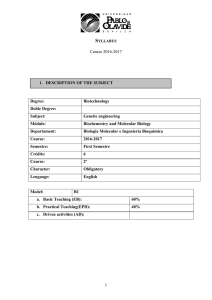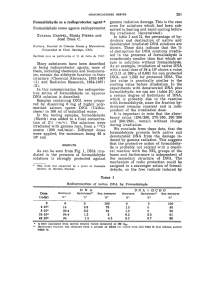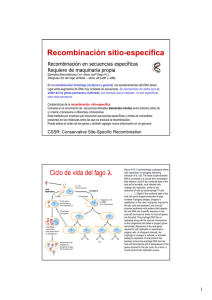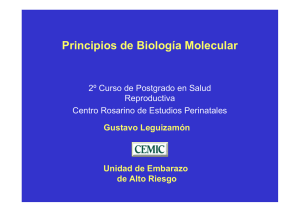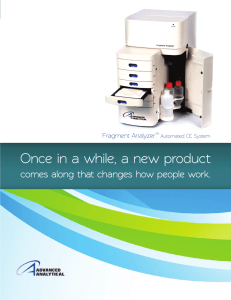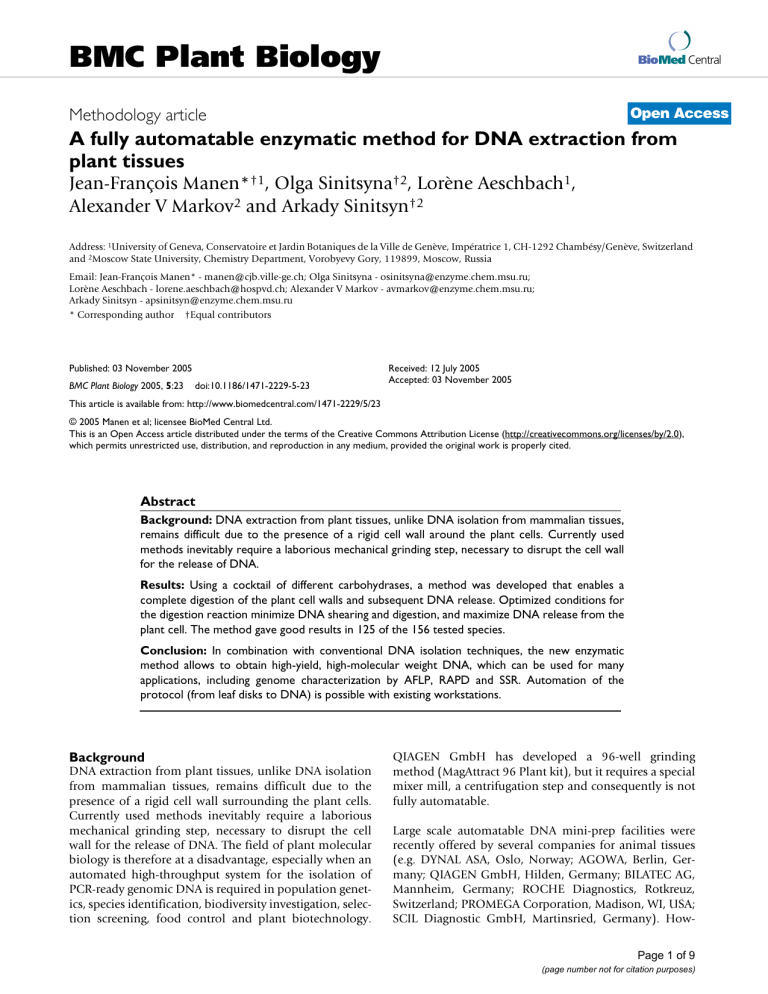
BMC Plant Biology BioMed Central Open Access Methodology article A fully automatable enzymatic method for DNA extraction from plant tissues Jean-François Manen*†1, Olga Sinitsyna†2, Lorène Aeschbach1, Alexander V Markov2 and Arkady Sinitsyn†2 Address: 1University of Geneva, Conservatoire et Jardin Botaniques de la Ville de Genève, Impératrice 1, CH-1292 Chambésy/Genève, Switzerland and 2Moscow State University, Chemistry Department, Vorobyevy Gory, 119899, Moscow, Russia Email: Jean-François Manen* - manen@cjb.ville-ge.ch; Olga Sinitsyna - osinitsyna@enzyme.chem.msu.ru; Lorène Aeschbach - lorene.aeschbach@hospvd.ch; Alexander V Markov - avmarkov@enzyme.chem.msu.ru; Arkady Sinitsyn - apsinitsyn@enzyme.chem.msu.ru * Corresponding author †Equal contributors Published: 03 November 2005 BMC Plant Biology 2005, 5:23 doi:10.1186/1471-2229-5-23 Received: 12 July 2005 Accepted: 03 November 2005 This article is available from: http://www.biomedcentral.com/1471-2229/5/23 © 2005 Manen et al; licensee BioMed Central Ltd. This is an Open Access article distributed under the terms of the Creative Commons Attribution License (http://creativecommons.org/licenses/by/2.0), which permits unrestricted use, distribution, and reproduction in any medium, provided the original work is properly cited. Abstract Background: DNA extraction from plant tissues, unlike DNA isolation from mammalian tissues, remains difficult due to the presence of a rigid cell wall around the plant cells. Currently used methods inevitably require a laborious mechanical grinding step, necessary to disrupt the cell wall for the release of DNA. Results: Using a cocktail of different carbohydrases, a method was developed that enables a complete digestion of the plant cell walls and subsequent DNA release. Optimized conditions for the digestion reaction minimize DNA shearing and digestion, and maximize DNA release from the plant cell. The method gave good results in 125 of the 156 tested species. Conclusion: In combination with conventional DNA isolation techniques, the new enzymatic method allows to obtain high-yield, high-molecular weight DNA, which can be used for many applications, including genome characterization by AFLP, RAPD and SSR. Automation of the protocol (from leaf disks to DNA) is possible with existing workstations. Background DNA extraction from plant tissues, unlike DNA isolation from mammalian tissues, remains difficult due to the presence of a rigid cell wall surrounding the plant cells. Currently used methods inevitably require a laborious mechanical grinding step, necessary to disrupt the cell wall for the release of DNA. The field of plant molecular biology is therefore at a disadvantage, especially when an automated high-throughput system for the isolation of PCR-ready genomic DNA is required in population genetics, species identification, biodiversity investigation, selection screening, food control and plant biotechnology. QIAGEN GmbH has developed a 96-well grinding method (MagAttract 96 Plant kit), but it requires a special mixer mill, a centrifugation step and consequently is not fully automatable. Large scale automatable DNA mini-prep facilities were recently offered by several companies for animal tissues (e.g. DYNAL ASA, Oslo, Norway; AGOWA, Berlin, Germany; QIAGEN GmbH, Hilden, Germany; BILATEC AG, Mannheim, Germany; ROCHE Diagnostics, Rotkreuz, Switzerland; PROMEGA Corporation, Madison, WI, USA; SCIL Diagnostic GmbH, Martinsried, Germany). HowPage 1 of 9 (page number not for citation purposes) BMC Plant Biology 2005, 5:23 http://www.biomedcentral.com/1471-2229/5/23 A B Figure 1 Electrophoretic aspect of enzymatically isolated DNA Electrophoretic aspect of enzymatically isolated DNA. A: Agarose gel electrophoresis of typical enzymatically isolated DNA from 24 different species (in the following order: Phlomis fructicosa, Humulus lupulus, Veratrum album, Scilla bifolia, Astragalus gummifer, Vitis vinifera, Centaurea macrocephala, Narcissus pseudonarcissus, Allium ampeloprassum, Salvia officinalis, Viburnum carlesii, Colchicum speciosum, Triticum turgidum, Polygonum chinensis, Lathyrus vernus, Tilia sp., Caragana sophorifolia, Urtica dioica, Lilium henryi, Polygonum multiflorus, Geranium sp., Lupinus sp., Crocus albiflorus, Helleborus dumetorum). After digestion, the DNA was isolated with Dynabeads® DNA DIRECT™ Universal magnetic beads. One fourth of the isolated DNA was loaded. The first and last lines were loaded with 250 ng of lambda/HindIII DNA (500 ng, bottom half, right). B: Agarose gel electrophoresis of DNA of 42 randomly chosen species (in the following order: Danae racemosa, Epimedium alpinum, Gladiolus palustris, Viburnum farreri, Euonymus bungeana, Weigela sp., Prunus padus, Rhodea japonica, Polygonatum multiflorum, Daphne japonica, Ribes petraeum, Asplenuim scolopendrium, Carex morrowii, Aruncus dioicus, Bletilla striata, Helleborus odoratus, Hedera helix, Brunnera macrophylla, Paeonia belladonna, Atropa belladonna, Solanum tuberosum, Beta vulgaris, Anethum graveolens, Allium fistulosum, Sison amomum, Uniola latifolia, Sinningia magnifica, Peperomia sp., Alnus sp., Tillia sp., Betula sp., Skimmia sp., Liriope spicata, Anthericum liliago, Inula ensifolia, Phlomis fruticosa, Lilium pumilum, Sorbaria sorbifolia, Dietes bicolor, Ilex aquifolium, Vitis vinifera, Setaria italica, Triticum aestivum, Nymphea sp., Pelargonium sp., Saintpaulia magungensis, Morinda sp., Zea mais). After enzymatic digestion in half of a 96 microtitration plate, DNA was isolated using Wizard® Magnetic 96 Plant System magnetic beads. One fourth of the isolated DNA was loaded. Page 2 of 9 (page number not for citation purposes) BMC Plant Biology 2005, 5:23 http://www.biomedcentral.com/1471-2229/5/23 Figure 2 disruption of leaf disks in a microtitration plate Enzymatic Enzymatic disruption of leaf disks in a microtitration plate. A flat bottom microtitration plate filled with 50 µl of digestion buffer and leaf disks of different species before the adding of the enzymatic cocktail. ever, because of their cell wall, the automation of the isolation of DNA from plants needs improvements. Whereas animal tissues need only a lysis buffer containing detergents and proteinase K to release their DNA, plant tissues need in addition a mixture of carbohydrase enzymes able to digest the cell wall. Enzymatic digestion of the cell wall of leaf tissues is routinely used for the production of protoplasts but this approach was never adapted for routine isolation of DNA from plant tissue. We describe here a new method for the lysis of plant tissues using a powerful cocktail of enzymes isolated from Trichoderma longibrachiatum, which digests the cell walls in order to liquefy the tissue without the need of grinding. The enzymatically released DNA is then isolated with commercially available magnetic beads. Results Leaf disks from 24 different species were digested by 5 µl of the enzymatic cocktail in 50 µl of digestion buffer. Thirty µl of liquid containing cell debris were drawn up and released DNA was isolated using Dynabeads® DNA DIRECT™ Universal kit (Dynal). Fig. 1A shows an agarose gel of 25% of the DNA isolated (10 µl). Most DNA are high-yield and of high-molecular weight. The amount of lambda DNA/Hind III loaded into the gel was 250 ng (or 500 ng, bottom half, right). The 23 kb band thus represented approximately 120 ng of DNA. The amount of plant genomic DNA obtained was variable from species to species. For some of them (Humulus lupulus, Vitis vinifera, Narcissus pseudonarcissus, Tilia sp., Lilium henryi and Helleborus dumetorum) the amount of loaded DNA was equal to or higher than 120 ng. As only 25% of the isolated DNA Page 3 of 9 (page number not for citation purposes) BMC Plant Biology 2005, 5:23 0.5 1 2 3 http://www.biomedcentral.com/1471-2229/5/23 4 5 hours visible. Several DNA extracts show partial degradation. No DNA is visible for Gladiolus palustris, Viburnum farreri, Weigela sp, Prunus padus, Ribes petraeum, Betula sp, Sorbaria sorbifolia, Pelargonium sp, Saintpaulia magungensis. In experiments described above, the cell wall digestion was done overnight for convenience. In order to follow the release of DNA at different times of enzymatic digestion, three 5 mm leaf disks from dry leaves of Ilex aquifolium were digested for 0.5 to 5 hours and the released DNA was isolated with the Wizard® Magnetic 96 Plant System kit (Promega). Fig. 3 shows that some DNA is already released at 0.5 h and that 3 to 4 hours are sufficient to release most of the DNA from this species. A short digestion time (1 to 3 hours) is sufficient for soft leaves such as Arabidopsis, Begonia, Brassica, Beta, Alium, Nicotiana, Triticum, Piper ...etc. However, incubation times need to be increased for Fragaria, Ribes, Oryza, Soya, Zea ...etc. Thus, although 1 to 3 hours are generally enough, the incubation time for a given species is not foreseeable and the appropriate length of digestion has to be determined experimentally before undertaking large-scale DNA isolations. Figure Time scale 3 DNA release from digesting leaf disks Time scale DNA release from digesting leaf disks. Triplicate essay of time scale DNA release from leaf disks of Ilex aquifolium at 0.5 to 5 hours of enzymatic digestion. Size marker: lambda/HindIII DNA. The method is highly reproducible. Fig. 4 shows 16 DNA isolated from dry leaf disks of Aster amellus and Ilex aquifolium and from seeds of Allium porum (cut into 2 pieces, see Materials and Methods), using the Wizard® Magnetic 96 Plant System kit (Promega). Fig. 5A shows a comparison of the amount of DNA isolated from Ilex aquifolium by a CTAB-based extraction method (lines 1–5, the protocol includes a treatment with RNase) and by the enzymatic method described here (lines 6–10) using the Wizard® Magnetic 96 Plant System. In both cases the amount of loaded DNA is one fifth of the DNA corresponding to a leaf disk of approximately 3 mg (dry weight). The amount of isolated DNA is similar for both methods. were loaded into the agarose gel, it can be estimated that the method permits the isolation of approximately 50 to 500 ng of genomic DNA from a leaf disk, depending on the species. As indicated by Fig. 5B, lambda DNA/Hind III does not show degradation during incubation with the enzymatic mix, nor in the presence of an overnight digesting leaf disk of Ilex at 50°C. This indicates that the digestion mix does not contain active DNase in the condition used for digestion, and that in the case of Ilex endogenous plant DNase are inactivated by the digestion mix. In the experiment described above, species on which the method was previously tested were selected. In order to empirically examine to what extent the method works on different species, simultaneous extraction of 48 randomly chosen species was carried out in a microtitration plate (as shown on Fig. 2) using the Wizard® Magnetic 96 Plant System kit (Promega) to isolate the released DNA (Fig. 1B). One fourth of the isolated DNA was loaded into the gel. In approximately 75% of the species, genomic DNA was Fig. 5 also shows PCR amplification of a plastid sequence (Fig. 5C), a multi-copy nuclear sequence (Fig. 5D) and a single-copy nuclear sequence (Fig. 5E) from 1 µl of DNA isolated by the enzymatic method from Ilex aquifolium, Aster amellus and Solanum tuberosum. The primers have been designed for the genus Ilex. Thus the few negative PCR in other species probably result from primer mismatch and not from polymerase inhibition. RAPD amplifications are also shown (Fig. 5F). Page 4 of 9 (page number not for citation purposes) BMC Plant Biology 2005, 5:23 A B C Figure 4 Reproducibility of enzymatical isolation of DNA Reproducibility of enzymatical isolation of DNA. (A) From leaf disks of 16 individuals of Aster amellus (one tenth of the isolated DNA was loaded), (B) From 16 leaf disks of Ilex aquifolium (one fifth of the isolated DNA was loaded) and (C) From 16 seeds of Allium porum (one fifth of the isolated DNA was loaded) using Wizard® Magnetic 96 Plant System magnetic beads. The enzymatic cocktail is produced from Trichoderma longibrachiatum fermentation and could be contaminated with its DNA. Moreover, in the case of a long overnight enzymatic digestion, there is a risk of contamination from bacteria or fungi covering the surface of plant tissues. To examine if such contamination could be a problem, fungi and bacteria specific PCR markers were tested on DNA extracted from (1) a digestion mix alone, or (2) a digestion mix "contaminated" with a Ilex aquifolium leaf disk removed after 10 min and further incubated overnight at 50°C, or (3) a mix digesting a Ilex aquifolium leaf disk overnight at 50°C (Fig. 6). No fungus (particularly Trichoderma longibrachiatum) or bacterial template could be detected. Instead, Ilex aquifolium templates are detected. Indeed, the ITS PCR product found in the digestion mix "contaminated" with a Ilex aquifolium leaf disk removed after 10 min and further incubated overnight at 50°C (line 10) has the same size as ITS of Ilex (larger than ITS of Trichoderma). Further sequencing demonstrated that this PCR product was an ITS sequence of Ilex and not of Trichoderma (data not shown). Similarly, the prokaryotic 16S rDNA sequence obtained from the mix digesting an Ilex aquifolium leaf disk overnight at 50°C (line 19) represented the plastid (prokaryotic) 16S rDNA of Ilex (data not shown), and not a bacterial sequence. http://www.biomedcentral.com/1471-2229/5/23 Discussion To the best of our knowledge, only a few non-grinding methods for isolation of DNA from plant tissue have been proposed, but only low amounts of DNA are generally obtained. Jhingan [1] followed by Williams and Ronald [2] proposed a chemical method using potassium ethyl xanthogenate that damages the cell wall, subsequently disrupts cells and releases the DNA. The method involves many steps and the amount of DNA released is generally ten times lower than traditional methods [1] and than our enzymatic method. A non-grinding method is proposed by SIGMA (Extract-N-Amp Plant PCR kit). It is not based on enzymatic digestion of the cell wall and the leaf tissue usually does not appear to be degraded after the treatment with the lysis buffer. The DNA extract is extremely crude, of low DNA content and often contains PCR inhibitors. Consequently, a 10-fold dilution of the extract is necessary to dilute inhibitors and the template concentration is at the limit of detection. Another method is based on the squashing of plant tissues on a nylon membrane [3] and subsequent elution of the little amount of DNA bound to the membrane for PCR amplification. An adaptation of this method is commercialized by WHATMAN (FTA® gene card). In conclusion, the advantage of our enzymatic nongrinding method of DNA extraction compared with the above-described methods is that a large amount of highquality DNA is isolated and that it is fully automatable. In a paper on the comparative analysis of different DNA extraction protocols from plant tissues, Csaikl et al. [4] wrote that "the problem of DNA extraction is still an important issue in the field of plant molecular biology" and that "a chemical tissue disruption method as used in mammalian cells might be the method of choice". Plant DNA purification is time-consuming and laborious. It is considered as the "bottleneck" of basic and applied research [5]. Thus there is a need for a quick, easy and automated method of plant DNA isolation. The method that we present here exactly fits this expectation. For a few species (approximately 25%, based on our results, see Additional file 1 and Fig. 2B) the method is not effective, but simple modifications of the protocol (particularly the digestion buffer) is expected to resolve the problem in the future. As the chemistry of plant tissues (contrary to animal tissues) is highly variable depending of species, it is not surprising that variable results are obtained. It was exactly the same situation with traditional DNA extraction methods where "recalcitrant" species needed further adaptations [6,7]. There are two situations in which the described protocol does not work (see Additional file 1). In the first case, the leaf disk of some species is not digested by the enzymatic cocktail. This is because some particular chemical compounds inhibit the enzymatic cocktail. Quercus represents such a Page 5 of 9 (page number not for citation purposes) BMC Plant Biology 2005, 5:23 http://www.biomedcentral.com/1471-2229/5/23 A C B D E F Figure Features5and properties of enzymatically isolated DNA Features and properties of enzymatically isolated DNA. A: comparison of the amount of DNA isolated from Ilex aquifolium leaves by a conventional extraction method (lines 1–5) and by the enzymatic method described here (lines 6–10). In both case the amount of loaded DNA is one fifth of the DNA corresponding to one leaf disk. B: Study of the stability of lambda DNA/Hind III during the digestion of leaf disks of Ilex. Line 1: one leaf disk alone; line 2: one leaf disk and lambda DNA/Hind III; line 3: lambda DNA/Hind III alone. C, D, E, and F: PCR amplification of enzymatically isolated DNA from Ilex aquifolium (line 1), Aster amellus (line 2), and Solanum tuberosum (line 3). C: PCR amplification of the plastid atpB-rbcL spacer. D: PCR amplification of ITS/5.8S. E: PCR amplification of the nuclear encoded plastid glutamine synthetase. F: RAPD amplification. case and high level of polyphenols (tannin) is suspected. Modifications of the digestion buffer by the addition of polyvinyl pyrrolidone (PVP [8]), or polyvinyl polypyrrolidone (PVPP [9]) or polyethylene glycol (PEG [10]) in order to neutralize polyphenolic compounds could greatly improve the method for "recalcitrant" species. In the second case, the leaf disk is perfectly digested but DNA is not released or, most probably, is highly degraded. This could be due to the release of endogenous recalcitrant nucleases or oxidative polyphenols during the digestion. In other cases (see Betula sp. in Additional file 1) different results can be obtained according the season of leaf harvesting, as it can be expected because of the modification of the chemical composition of the cell wall during the year [11]. To deal with species-dependent variability, it is obviously necessary to determine the optimal digestion conditions for each plant sample. In fact, the duration of incubation is not a problem because the protocol is entirely automatable from solid leaf disks to the PCRready DNA. Even if, in some case, it could be longer than mechanical grinding in reaction tube or plate, any human intervention is needed. Conclusion In summary, the protocol is simple and reliable, does not require grinding, centrifuging, or the use of hazardous Page 6 of 9 (page number not for citation purposes) BMC Plant Biology 2005, 5:23 1 2 3 4 5 http://www.biomedcentral.com/1471-2229/5/23 6 7 8 9 10 11 12 ITS 13 14 15 16 17 18 19 20 16S rDNA Figure 6 Contamination checking: PCR markers for fungi and bacteria in DNA isolated by the enzymatic method Contamination checking: PCR markers for fungi and bacteria in DNA isolated by the enzymatic method. Lines 1 to 12: Internal transcribed spacer (ITS) of ribosomal DNA amplified with eukaryotic specific universal primers ITS1 and ITS4 [17]. Lines 13 to 20: 16S ribosomal DNA amplified with prokaryotic specific universal primers 9f and 1429r [18]. Amplifications from respectively 10, 1, 0.1 and 0.01 pg of genomic DNA of Trichoderma longibrachiatum (lines 1 to 4), Ilex aquifolium (lines 5 to 8) and Artrospira sp. (lines 13 to 16). Amplifications of DNA isolated from a digestion mix alone (lines 9 and 17), a digestion mix "contaminated" with an Ilex aquifolium leaf disk removed after 10 min and further incubated overnight at 50°C (lines 10 and 18) and a mix digesting an Ilex aquifolium leaf disk overnight at 50°C (lines 11 and 19). Line 12 and 20: negative controls. chemicals. A large number of samples can be processed simultaneously, and full automation of the protocol is possible with existing workstations. Many different species were successfully tested. The method can be adapted to each species by modification of the digestion buffer, of the amount of the enzymatic cocktail added during the digestion or of the digestion time. The method is perfectly adapted to situations when highthroughput isolation of PCR-ready genomic DNA is required. Moreover, because of the high-yield and highmolecular weight DNA reliably obtained, sensitive PCRbased techniques could be applied: AFLP (Amplified Fragment Length Polymorphism), RAPD (Random Amplified Polymorphic DNA), SSR (Simple Sequence Repeat polymorphism). Methods Enzymatic cocktail A mixture of cell wall degrading enzymes was isolated from Trichoderma longibrachiatum Rifai (strain TW-1, deposited in the Russian Collection of Microorganisms under the number VKMF-3934D). The fermenting medium (7 liters) consisted of wheat bran (25 g/L), solid corn steep (25 g/L), hydrolyzed starch (45 g/L), mineral salts and fed by lactose (25% solution at feeding rate of 50 ml/h) after the first 48 hours of fermentation. The fermentation was carried out at 32°C for 144 h. Extracellular secreted enzymes were then isolated by centrifugation (5000 g for 30 min.) and concentrated by ultrafiltration (molecular weight cut-off 10 kD) at 200–250 mg/ml of protein. The obtained enzymatic cocktail was used directly for DNA isolation from plant tissues. It contains, among others, cellulases, beta-glucanases, xylanases, mannanases, xyloglucanases, pectinases, glycosidases (such as beta-glucosidae, beta-xylosidase, alpha-L-arabinofuranosidase, alpha-galactosidase). Additional file 2 gives some enzymatic activities of the cocktail, as assayed according to Ghose [12]. Ribosomal DNA from Trichoderma longibrachiatum was not detected by PCR in the enzymatic cocktail, and cellulase from this organism is in the GRAS list (Generally Recognized As Safe) of the US Food and Drug Administration http://www.accessdata.fda.gov/ scripts/cdrh/cfdocs/cfcfr/CFRSearch.cfm?CFRPart=184 under the number §184.1250. The enzymatic cocktail remains stable at least for two years at 4°C. Substantial aliquots of the enzymatic preparation can be obtained from the first author. Plant tissues One hundred and fifty six plant species from the Botanical Garden of Geneva were tested with the described enzymatic method of DNA isolation (Additional file 1). Leaf tissue was used in most cases and some seeds were also tested as indicated. Protocols Leaf disks (5 mm in diameter) were incubated in 50 µl of digestion buffer (175 mM EDTA [pH 8.0], 100 mM sodium acetate [pH 4.6], 1% triton X100) and 5 µl of the enzymatic cocktail. After digestion (50°C with constant agitation from 3 to 16 hours, depending of species), 30 µl of liquid containing cell debris were drawn up and 200 µl of Dynabeads® DNA DIRECT™ Universal (Dynal ASA, Oslo, Norway) was added. The protocol of DNA isolation Page 7 of 9 (page number not for citation purposes) BMC Plant Biology 2005, 5:23 http://www.biomedcentral.com/1471-2229/5/23 was then conducted according the manufacturer's instructions in 1.5 ml microtubes. the isolated DNA was added to 25 µl of standard PCR reaction (annealing temperature of 37°C). Alternatively, leaf disks of 48 randomly chosen species were digested simultaneously overnight in the same conditions on a sealed flat bottom microtitration plate (as shown on Fig. 2). Genomic DNA was further isolated using the Wizard® Magnetic 96 Plant System (Promega Corporation, Madison, WI, USA) and the MagnaBot® 96 Magnetic Separation Device, according to the manufacturer's instructions. For both protocols, DNA was eluted in 40 µl of TE8 (10 mM Tris-HCl, 1 mM EDTA, pH 8.0.). Fresh leaves were generally used, but silica gel-dried leaf tissue can also be digested. As well as leaf tissues, seed tissues were tested. To allow the enzyme solution to penetrate the seed tissue, seeds were broken into pieces of 1–3 mm in side, and one piece was used for DNA isolation. To examine the amount of DNA isolated, 10 µl of the eluted DNA was loaded on a 1% agarose gel containing ethidium bromide and the DNA band was compared with a known amount of lambda DNA /Hind III loaded into the gel. Authors' contributions Stability of the DNA during the enzymatic digestion of plant tissue One µg of lambda DNA/Hind III was added to the digestion mixture alone or in the presence of a leaf disk of Ilex aquifolium and incubated overnight at 50°C. DNA was then isolated with the Wizard® Magnetic 96 Plant System (Promega) and one fifth of this DNA was loaded for agarose gel electrophoresis. Comparison with a conventional method of DNA extraction The amount of DNA isolated by a method of DNA extraction based on CTAB (hexadecyltrimethylammonium bromide, [13]) was compared to the amount of DNA isolated by the enzymatic method described here for dry leaf tissue of Ilex aquifolium. Known amounts (from 14 to 53 mg) of liquid nitrogen-ground leaf tissue of Ilex were conventionally extracted and the isolated DNA was re-dissolved in the proportion of 50 µl of TE buffer per leaf disk (approximately 3 mg), the proportion used in the enzymatic method. The amounts of DNA were then compared by agarose gel electrophoresis. Genomic DNA analysis PCR amplifications of a plastid fragment (the atpB-rbcL spacer, [14]), a multi-copy nuclear sequence (ribosomal ITS/5.8S, [15]) and a single-copy nuclear sequence (nuclear encoded plastid glutamine synthetase, [16]) were tested on DNA isolated from a leaf disk of Ilex aquifolium, Aster amellus and Solanum tuberosum. One µl of isolated DNA were used in 25 µl of standard PCR reactions (annealing temperature of 55°C). RAPD amplifications were tested with primer 5' CGGCCCCTGT using 1 µl of JFM conceived of the method, carried out preliminary experiments and drafted the manuscript. OS and AVM checked and analyzed the biological and chemical activities of the enzymatic cocktail. LA accumulated and interpreted the data. AS designed the enzymatic cocktail. Additional material Additional File 1 List of species investigated. Click here for file [http://www.biomedcentral.com/content/supplementary/14712229-5-23-S1.doc] Additional File 2 Typical enzymatic activities and properties of the cocktail used for plant DNA isolation. Click here for file [http://www.biomedcentral.com/content/supplementary/14712229-5-23-S2.doc] Acknowledgements We would like to thank R. Mayor who routinely uses this method for microsatellite analysis of Aster amellus, providing the picture for Fig. 4, and Catalys AG, Switzerland (Promega corporation) who provided, under advantageous conditions, their Wizard® Magnetic 96 Plant System. We also thank Michelle Price for many English adjustments. This work was supported by the Swiss National Science Foundation (grant SCOPES 7SUPJ062282). References 1. 2. 3. 4. 5. 6. 7. 8. 9. Jhingan A: A novel technology for DNA isolation. Methods Mol Cell Biol 1992, 3:15-22. Williams CE, Ronald PC: PCR template-DNA isolated quickly from monocot and dicot leaves without tissue homogenization. Nucl Acids Res 1994, 22:1917-1918. Langridge U, Schwall M, Langridge P: Squashes of plant tissue as substrate for PCR. Nucl Acids Res 1991, 19:6954. Csaikl UM, Bastian H, Brettschneider R, Gauch S, Meir A, Schauerte M, Scholz F, Sperisen C, Vornam B, Ziegenhagen B: Comparative analysis of different DNA extraction protocols: a fast, universal maxi-preparation of high quality plant DNA for genetic evaluation and phylogenetic studies. Plant Mol Biol Rep 1998, 16:69-86. Mace ES, Buhariwalla HK, Crouch HJ: A high-throughput DNA extraction protocol for tropical molecular breeding programs. Plant Mol Biol Rep 2003, 21:459a-459h. Weeb DM, Knapp SJ: DNA extraction from a previously recalcitrant plant genus. Plant Mol Biol Rep 1990, 8:180-185. Baker SS, Rugh CL, Kamalay J: RNA and DNA isolation from recalcitrant plant tissues. Biotechniques 1990, 9:268-272. Porebski S, Bailey LG, Baum BR: Modification of a CTAB DNA extraction protocol for plants containing high polysaccharide and polyphenol components. Plant Mol Biol Rep 1997, 15:8-15. Lodhi MA, Ye G-N, Weeden NF, Reisch BI: A simple and efficient method for DNA extractions from grapevine cultivars and Vitis species. Plant Mol Biol Rep 1994, 12:6-13. Page 8 of 9 (page number not for citation purposes) BMC Plant Biology 2005, 5:23 10. 11. 12. 13. 14. 15. 16. 17. 18. 19. http://www.biomedcentral.com/1471-2229/5/23 Carlson JE, Tulsieram LK, Glaubitz JC, Luk VMK, Kauffeldt C, Rutledge R: Segregation of random amplified DNA markers in F1 progeny of conifers. Theor Appl Genet 1991, 83:194-200. Boudet A-M: A new view of lignification. Trends Plant Sci 1998, 3:67-71. Ghose TK: Measurement of cellulase activities. Pure Appl Chem 1987, 59:257-268. Doyle JJ, Doyle JL: A rapid DNA isolation procedure for small quantities of leaf tissue. Phytochem Bull 1987, 19:11-15. Cuénoud P, Del Pero Martinez MA, Loizeau P-A, Spichiger R, Andrews S, Manen J-F: Molecular phylogeny and biogeography of the genus Ilex L. (Aquifoliaceae). Ann Bot 2000, 85:111-112. Manen J-F, Boulter MC, Naciri-Graven Y: The complex history of the genus Ilex L. (Aquifoliaceae): evidence from the comparison of plastid and nuclear DNA sequences and from fossil data. Plant Syst Evol 2002, 235:79-98. Emshwiller E, Doyles JJ: Chloroplast-expressed glutamine synthetase (ncpGS): potential utility for phylogenetic studies with an example from Oxalis (Oxalidaceae). Mol Phyl Evol 1999, 12:310-319. White TJ, Bruns T, Lee S, Taylor JW: Amplification and direct sequencing of fungal ribosomal RNA genes for phylogenetics. In PCR Protocols: A Guide to Methods and Applications Edited by: Innis MA, Gelfand DH, Sninsky JJ, White TJ. Academic Press, Inc., New York; 1990:315-322. Weisburg WG, Barns S, Pelletier DA, Lane DJ: 16S ribosomal DNA amplification for phylogenetic study. J Bacteriol 1991, 173:679-703. Chaplin MF, Kennedy JF: Carbohydrate analysis: A practical approach. second edition. Oxford University Press, Oxford, New York, Tokyo; 1994:4. Publish with Bio Med Central and every scientist can read your work free of charge "BioMed Central will be the most significant development for disseminating the results of biomedical researc h in our lifetime." Sir Paul Nurse, Cancer Research UK Your research papers will be: available free of charge to the entire biomedical community peer reviewed and published immediately upon acceptance cited in PubMed and archived on PubMed Central yours — you keep the copyright BioMedcentral Submit your manuscript here: http://www.biomedcentral.com/info/publishing_adv.asp Page 9 of 9 (page number not for citation purposes)

